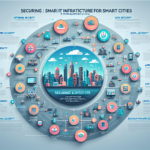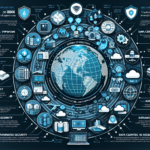Securing IT infrastructure for public transportation systems is critical to ensure the availability, integrity, and confidentiality of systems that support operations, payments, passenger information, and safety. As an IT manager overseeing such infrastructure, here is a comprehensive approach to securing your systems:
1. Conduct Risk Assessments and Identify Threats
- Risk Analysis: Assess all IT assets (datacenter, storage, servers, applications, etc.) to identify vulnerabilities and risks specific to public transportation systems.
- Threat Modeling: Identify potential attackers (e.g., hackers, insiders) and threats (e.g., ransomware, DDoS attacks).
- Compliance Standards: Ensure alignment with transportation-specific regulations (e.g., GDPR, CISA directives, NIST frameworks).
2. Secure Datacenter and Physical Infrastructure
- Physical Security: Implement access controls like keycard systems, biometric authentication, and security cameras for the datacenter.
- Environment Monitoring: Use sensors to detect environmental threats (e.g., temperature, humidity, fire).
- Redundancy: Ensure redundant power supplies, cooling systems, and failover mechanisms to maintain service availability.
3. Network Security
- Segmentation: Divide the network into segments (e.g., operational technology vs. IT systems) using VLANs or firewalls to minimize lateral movement during breaches.
- Firewalls and IDS/IPS: Deploy next-generation firewalls and intrusion detection/prevention systems to monitor and block suspicious traffic.
- VPNs: Use encrypted VPNs for remote access to the transportation systems infrastructure.
4. Secure Servers and Virtualized Environments
- Hardening: Disable unnecessary services, remove default credentials, and apply the principle of least privilege on servers.
- Patch Management: Regularly update operating systems (Windows, Linux) and applications to address vulnerabilities.
- Hypervisor Security: Ensure your virtualization platform (VMware, Hyper-V, etc.) is configured securely and patched against exploits.
5. Storage and Backup Security
- Encryption: Ensure all storage systems and backups (on-premise or cloud) are encrypted to protect sensitive data.
- Immutable Backups: Use backup systems with immutable features to prevent tampering or deletion by ransomware.
- Backup Strategy: Implement a 3-2-1 backup rule (3 copies of data, 2 different storage types, 1 offsite location).
6. Kubernetes and Container Security
- Container Scanning: Scan container images for vulnerabilities before deployment.
- RBAC: Use Role-Based Access Control (RBAC) to restrict permissions in Kubernetes clusters.
- Securing Secrets: Use tools like Kubernetes Secrets or HashiCorp Vault to securely manage API keys and credentials.
7. AI and IoT Security
- AI Model Security: Protect AI models used for predictive maintenance, traffic optimization, or fraud detection by securing training data and model endpoints.
- IoT Device Security: Secure IoT sensors and devices used in transportation (e.g., ticketing systems, passenger counters) by ensuring firmware updates and strong authentication mechanisms.
8. GPU Server Security
- Firmware Updates: Regularly update GPU drivers and firmware used in AI or graphics workloads.
- Workload Isolation: Isolate GPU workloads using containerization or virtualized GPU solutions to prevent unauthorized access.
- Monitoring: Monitor GPU usage for unusual activity that may indicate misuse or compromise.
9. Cybersecurity Best Practices
- Endpoint Security: Deploy antivirus/EDR solutions on endpoints, including public kiosks and payment terminals.
- Multi-Factor Authentication (MFA): Require MFA for all users accessing IT infrastructure.
- SIEM Tools: Use Security Information and Event Management (SIEM) tools to monitor and analyze logs for suspicious activity.
- Incident Response Plan: Develop and regularly test a response plan to quickly address breaches or outages.
10. Employee Awareness and Insider Threat Mitigation
- Training: Regularly train staff on cybersecurity best practices, phishing recognition, and secure handling of data.
- Access Controls: Implement strict access controls and monitor for unusual behavior to mitigate insider threats.
11. Disaster Recovery and Business Continuity
- Recovery Plan: Develop and maintain a disaster recovery plan tailored to public transportation systems.
- Failover Systems: Ensure failover systems for critical services (e.g., ticketing, passenger information) to reduce downtime.
- Testing: Regularly test backups, failover systems, and recovery plans.
12. Regular Audits and Penetration Testing
- Audits: Perform regular security audits to verify compliance and identify vulnerabilities.
- Penetration Testing: Conduct penetration tests to assess the resilience of your infrastructure against real-world attacks.
Tools and Technologies
- Firewall: Palo Alto Networks, Fortinet, or Cisco.
- EDR: CrowdStrike, SentinelOne, or Microsoft Defender.
- Kubernetes Security: Aqua Security, Sysdig, or Kube-bench.
- Backup: Veeam, Commvault, or Rubrik.
- SIEM: Splunk, QRadar, or Elastic Security.
- AI Security: NVIDIA Triton, TensorFlow Security, or OpenAI API security tools.
Final Thoughts
Public transportation systems are critical infrastructure and are increasingly targeted by cyberattacks due to their importance and potential impact. By implementing a layered security approach, leveraging modern tools, and fostering a culture of cybersecurity awareness, you can significantly reduce the risk and ensure the availability and safety of the systems under your management.


